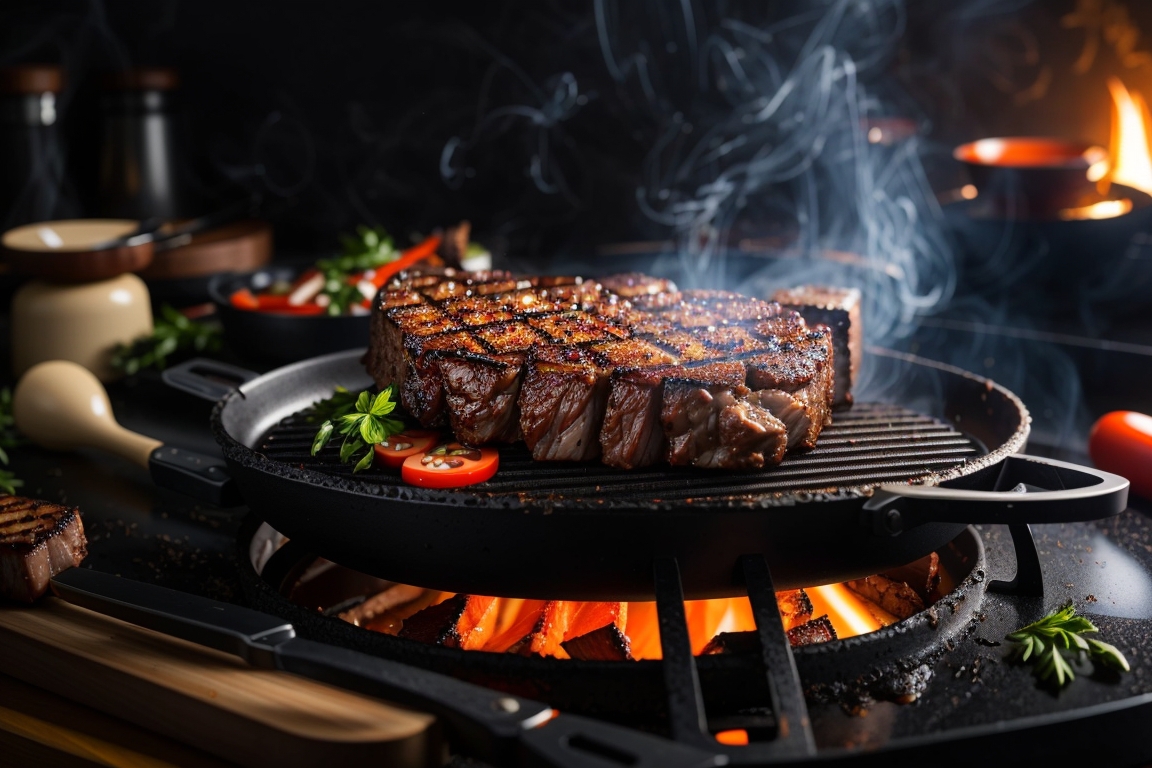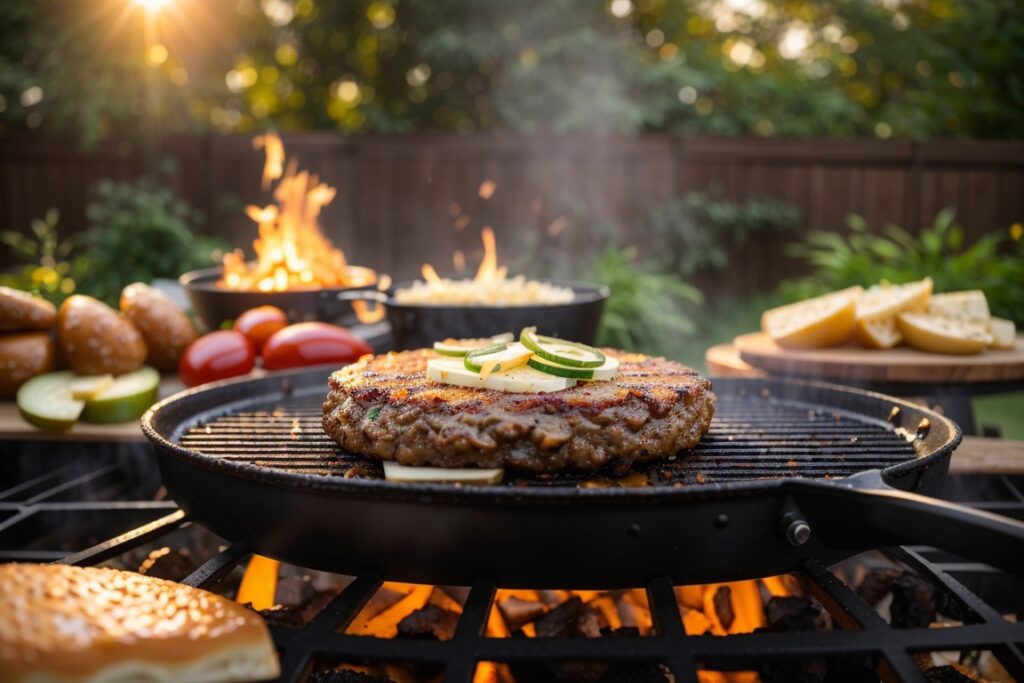When it comes to the world of culinary delights, grilling is truly an art form. The enticing sizzle of food hitting the grill, the mouthwatering aroma that fills the air, and the delectable flavors that result from this cooking method are simply unmatched. Whether you’re an avid grilling enthusiast or someone who’s just looking to elevate their cooking skills, you’ve probably heard of the trusty grill pan. In this article, we’ll take a deep dive into the realm of grill pans, exploring their features, benefits, and sharing some valuable tips on how to make the most of this incredibly versatile kitchen tool.
Table of Contents
Introduction
Types of Grill Pans
2.1 Cast Iron Grill Pans
2.2 Non-Stick Grill Pans
2.3 Stainless Steel Grill Pans
Advantages of Using a Grill Pan
Choosing the Right Grill Pan for You
Seasoning Your Grill-Pan
Prepping Your Ingredients
Grilling Techniques
7.1 Direct Grilling
7.2 Indirect Grilling
7.3 Pan-Searing
Maintaining Your Grill-Pan
Cleaning and Care
Recipes for Grill Pan Success
10.1 Grilled Chicken with Lemon Herb Marinade
10.2 Grilled Vegetables Medley
Safety Precautions
Common Mistakes to Avoid
Grilling Tips and Tricks
Conclusion
FAQs
Introduction
Let’s kick things off by getting acquainted with grill pans. These nifty kitchen tools are an excellent addition to any culinary arsenal. They offer a convenient way to achieve those coveted grill marks and infuse smoky flavors into your food, even if you don’t have access to an outdoor grill. Grill pans come in various materials, each with its unique advantages, making them a versatile choice for home cooks.
Types of Grill Pans
2.1 Cast Iron Grill Pans
Cast iron grill pans are renowned for their exceptional heat retention and even heat distribution. They are perfect for achieving those beautiful grill marks on steaks, burgers, and a variety of veggies. What’s more, you can use them on both stovetops and in the oven, giving you the flexibility to experiment with different cooking methods.
2.2 Non-Stick Grill Pans
Non-stick grill pans are a favorite among those who value easy cleanup. These pans prevent food from sticking, making them ideal for delicate items like fish and foods that tend to crumble easily. They also require less oil, which is a plus for health-conscious cooks.
2.3 Stainless Steel Grill Pans
Stainless steel grill pans are beloved for their durability and resistance to rust and staining. They excel in high-heat grilling and are a breeze to clean. While they may not be as non-stick as other options, professional chefs often favor them for their reliability.
Advantages of Using a Grill Pan
So, why should you consider using a grill pan in your cooking adventures? Well, there are several advantages. First and foremost, grill pans allow you to enjoy the pleasures of grilling year-round, no matter the weather. They also give you precise control over your cooking and the ability to impart that delightful smoky flavor to your dishes. Moreover, grill pans are versatile enough to accommodate various cooking styles, from direct grilling to pan-searing.
Choosing the Right Grill Pan for You
Selecting the perfect grill pan for your needs involves considering factors like the material, size, and handle design. Picking the right pan can significantly enhance your grilling experience and ensure consistently delicious results.
Selecting the ideal grill pan is crucial to achieving the best grilling results in your kitchen. Several factors should influence your decision to ensure you get a pan that meets your cooking needs:
Material: The material of the grill pan significantly impacts its performance. Cast iron grill pans are renowned for their exceptional heat retention and even cooking. They develop a natural non-stick surface over time but require seasoning and regular maintenance. Non-stick grill pans are convenient for easy cleaning but may need replacement over time. Stainless steel grill pans are durable and resist staining, but they may not be as non-stick.
Size: Consider the size of the grill pan based on your typical cooking requirements. A larger pan is suitable for cooking for a family, while a smaller one is more fitting for individual or couple servings.
Handle: A well-designed handle is essential for safe and comfortable use. Look for a grill pan with an ergonomic handle that stays cool during cooking.
Weight: Keep in mind that cast iron grill pans can be heavy, which may affect maneuverability. Ensure you’re comfortable handling the weight on your stovetop or grill.
Surface: Grill pans can come with raised ridges for creating grill marks or a flat surface for versatility. Choose based on your preferred cooking style and the types of dishes you intend to prepare.
Compatibility: Verify that the grill pan is compatible with your cooking heat source, whether it’s gas, electric, induction, or outdoor grilling.
Maintenance: Consider your willingness to maintain the grill pan. Non-stick pans are easier to clean, while cast iron pans require proper seasoning and maintenance for long-term use.
Price: Establish a budget and look into choices that fall inside it. While premium grill pans may offer additional features, there are often affordable choices that deliver excellent results.
Brand Reputation: Investigate the reputation of the brand for product quality and customer support. Reviews and recommendations may provide useful information.
Warranty: Check if the grill pan comes with a warranty. A reliable warranty can offer peace of mind regarding the pan’s durability.
Cooking Style: Consider your cooking preferences. If you enjoy achieving grill marks and searing meats, opt for a ridged grill pan. If you desire versatility for various dishes, a flat grill pan may be more suitable.
Additional Features: Some grill pans come with lids, which can be advantageous for certain cooking techniques or keeping food warm.
Seasoning Your Grill-Pan
For cast iron grill pans, seasoning is a critical step. It’s the secret sauce that creates a natural non-stick surface and prevents rusting. We’ll walk you through the seasoning process to ensure your pan is primed and ready for action.
Grilling Techniques
7.1 Direct Grilling
Cooking food on a grill directly over the heat source is known as direct grilling. This technique is perfect for thin cuts of meat, seafood, and vegetables that cook quickly.
7.2 Indirect Grilling
Indirect grilling is your go-to method for larger cuts of meat or dishes that require slower cooking. It entails placing your food away from the heat source while maintaining a consistent temperature within the grill pan.
7.3 Pan-Searing
Pan-searing is a delightful hybrid technique that combines the best of grilling and pan-frying. It’s excellent for achieving a crispy exterior while keeping the interior juicy and tender.
Maintaining Your Grill-Pan
To prolong the lifespan of your grill pan, knowing how to maintain it properly is crucial. We’ll share some valuable tips to help you prevent rust and preserve its cooking surface.
Cleaning and Care
Cleaning your grill pan can be a breeze if you know the right methods. We’ll guide you through the steps to ensure your pan stays in top-notch condition.
Recipes for Grill Pan Success
10.1 Grilled Chicken with Lemon Herb Marinade
Get ready to tantalize your taste buds with this mouthwatering grilled chicken recipe. It combines the smoky goodness of a grill pan with a zesty lemon herb marinade that’s sure to impress.
10.2 Grilled Vegetables Medley
For a healthy and flavorful side dish, consider grilling a medley of colorful vegetables with your trusty grill pan. They’ll be a hit at your next barbecue gathering.
Grill pans are a versatile tool in the American kitchen, allowing you to create mouthwatering dishes all year round. Here are 10 popular grill pan recipes that Americans love:
Grilled Steak with Chimichurri Sauce: Season your favorite steak with salt and pepper, then sear it on a hot grill pan to your desired doneness. Top it with homemade chimichurri sauce for a burst of flavor.
Grilled Chicken Fajitas: Marinate chicken strips in a zesty fajita seasoning, then grill them along with bell peppers and onions. Serve with your preferred toppings and warm tortillas.
Pan-Grilled Burgers: Make juicy burgers by seasoning ground beef with your favorite spices. Grill them on the pan and add cheese, lettuce, tomato, and pickles for a classic American burger.
Grilled Vegetable Platter: Grill a colorful medley of vegetables like zucchini, bell peppers, asparagus, and mushrooms. Drizzle with olive oil, balsamic vinegar, and fresh herbs for a healthy side dish.
Grilled Shrimp Tacos: Season shrimp with a blend of spices, then grill until they turn pink and slightly charred. Serve in tortillas with slaw, avocado, and a creamy cilantro-lime sauce.
Grilled Portobello Mushrooms: Marinate large Portobello mushrooms in balsamic vinaigrette and grill until tender. These make a fantastic meatless burger alternative.
Lemon Herb Grilled Salmon: Coat salmon fillets with a mixture of lemon juice, garlic, and fresh herbs. Grill until flaky and serve with a side of roasted vegetables.
Grilled Corn on the Cob: Grill fresh corn on the cob with the husks on for a smoky flavor. Peel back the husks and brush with garlic butter for a delectable side dish.
Grilled Veggie Quesadillas: Make veggie-packed quesadillas by grilling tortillas filled with a mix of grilled vegetables, cheese, and a touch of salsa.
Grilled Pineapple Dessert: Grill pineapple slices until they caramelize and develop grill marks. Serve with a scoop of vanilla ice cream and a drizzle of honey for a simple yet delightful dessert.
These grill pan recipes are favorites across the United States, offering a wide range of flavors and options for every palate. Fire up your grill pan and enjoy these delicious creations at home.
Safety Precautions
When it comes to grilling, safety is paramount. We’ll discuss essential safety measures, including proper ventilation, handling hot pans, and preventing flare-ups.
Proper Ventilation: Ensure that your kitchen is well-ventilated. Grilling indoors can produce smoke, so use an exhaust fan or open windows to maintain good airflow.
Heat Source Awareness: Always be aware of the heat source. Grill pans can become extremely hot, so use oven mitts or handle covers when handling them.
Keep Flammable Items Away: Clear your cooking area of any flammable items such as paper towels, dishcloths, or curtains. Safety first!
Use a Lid or Splatter Guard: To minimize oil splatter and potential burns, consider using a lid or splatter guard while grilling.
Watch for Flare-Ups: Be prepared for flare-ups when grilling fatty meats. Keep a lid or baking sheet nearby to smother any flames if necessary.
Safe Utensils: Use appropriate utensils like long tongs or spatulas with heat-resistant handles to flip and handle food safely.
Avoid Crowding the Pan: Overcrowding the grill pan can lead to uneven cooking and may cause accidents. Leave enough space between food items.
Keep Children and Pets Away: Ensure that children and pets are at a safe distance from the grill pan to prevent accidental burns.
Use Oven Mitts or Towels: When removing the grill pan from the stovetop or oven, always use oven mitts or towels to protect your hands from burns.
Monitor Cooking Progress: Stay attentive to your cooking. Grilling often requires quick adjustments to temperature and cooking times to avoid overcooking or burning.
Use Caution with Hot Oil: If you’re using oil for grilling, be cautious when adding it to the hot pan. Slowly pour the oil to prevent splatters.
Turn Off Heat: Once you’re done grilling, turn off the heat source and allow the grill pan to cool down before cleaning or storing it.
Clean Safely: Be careful when cleaning a hot grill pan. Wait for it to cool down sufficiently before cleaning to avoid burns.
Grilling Tips and Tricks
Unlock the secrets of grilling success with our insider tips and tricks. From achieving those perfect grill marks to mastering the art of temperature control, we’ve got you covered.
Grilling is an art that can turn ordinary ingredients into extraordinary dishes. Whether you’re a seasoned griller or just starting out, these tips and tricks will help you elevate your grilling game:
Preheat Your Grill: Always warm your grill before using it to cook. This guarantees even cooking and avoids sticking.
Clean Your Grill Grates: A clean grill is essential. Use a grill brush to remove residue and food particles from the grates before heating it up.
Oil the Grates: To prevent sticking, lightly oil the grill grates with a high-heat cooking oil using a paper towel or brush.
Marinate for Flavor: Marinating meats and veggies adds depth of flavor. Aim for at least 30 minutes of marinating time, but longer is often better.
Season Generously: Don’t skimp on seasoning. Use a variety of herbs, spices, and rubs to enhance the taste of your dishes.
Direct vs. Indirect Heat: Know when to use direct heat (right over the flame) and indirect heat (off to the side). While indirect heat is best for gradual or slow cooking, direct heat works well for searing.
Lid Control: Keep the lid closed as much as possible. Opening it frequently lets out heat and extends cooking times.
Use a Meat Thermometer: Invest in a meat thermometer to ensure your proteins are cooked to the desired level of doneness.
Rest Your Meat: Allow grilled meats to rest for a few minutes after cooking. This helps redistribute juices and keeps the meat tender.
Experiment with Wood Chips: Soak wood chips in water and add them to the grill for a smoky flavor. Different woods impart unique flavors, so try various options.
Vegetable Basket: Use a grill basket for small or delicate items like sliced veggies.They can’t fall through the grate because of it.
Flip Only Once: Resist the urge to flip food constantly. Flip it just once to get those beautiful grill marks.
Baste with Care: If using a marinade for basting, do so in the last few minutes of grilling to avoid burning.
Keep a Spray Bottle Handy: Have a spray bottle of water nearby to tame any flare-ups.
Safety First: Always practice grill safety. Keep a fire extinguisher, oven mitts, and grilling tools nearby.
Get Creative: Don’t limit yourself to traditional grilling. Experiment with fruits, desserts, and unexpected ingredients for unique flavors.
Plan Your Sides: While your main dish grills, prepare side dishes or condiments. Timing is key for a coordinated meal.
Clean After Use: Clean the grill grates after cooking while they’re still warm. It’s easier to remove residue then.
Keep a Grilling Diary: Note your successful recipes and techniques in a grilling diary. It’ll help you replicate your successes.
Enjoy the Process: Grilling is not just about the end result; it’s about the experience. Relax, savor the aromas, and enjoy the company of friends and family.
With these tips and tricks, you’ll be well on your way to becoming a grilling maestro, creating delicious and memorable meals for all to enjoy.
Conclusion
In closing, a grill pan is a fantastic tool that allows you to bring the joy of grilling indoors, no matter the season. Whether you’re grilling up a juicy steak, some mouthwatering veggies, or your favorite seafood, these pans offer versatility and flavor that will delight your palate. With the right techniques and a bit of practice, you’ll soon become a grill pan maestro.
FAQs
Do grill pans work with induction cooktops?
Absolutely! Induction cooktops are compatible with a wide variety of grill pans. Just keep an eye out for pans with a magnetic base.
Does a nonstick grill pan require oiling?
Even though cooking with non-stick pans uses less oil, it’s still a good idea to gently oil your food for taste and to keep it from sticking.
How can I remove tough residue from a grill pan?
Make a paste with water and baking soda for obstinate residue. Scrub the pan lightly, then thoroughly rinse and dry it.
Will a grill pan work in the oven?
Yes, indeed! Cast iron and stainless steel grill pans are oven-safe and can handle high temperatures.
What’s the best way to store a grill pan?
To prevent rust, store your grill pan in a dry place and consider lightly oiling it before long-term storage.
Now that you’ve gained a comprehensive understanding of grill pans, it’s time to fire up your stovetop and start grilling delicious dishes. Embrace the world of indoor grilling and savor the mouthwatering results.








